OLDSMOBILE AURORA 1996 Owners Manual
Manufacturer: OLDSMOBILE, Model Year: 1996, Model line: AURORA, Model: OLDSMOBILE AURORA 1996Pages: 388, PDF Size: 20.24 MB
Page 261 of 388

4. There’s a temperature sensor on the corner of the air
cleaner cover. Use a screwdriver to release the
sensor’s electrical connector retainer, and pull up.
A
5. Unsnap the two clamps by pushing down on the top
of the air cleaner cover and pushing in on the clamps
toward the center
of the cover. Then remove the cover.
ProCarManuals.com
Page 262 of 388
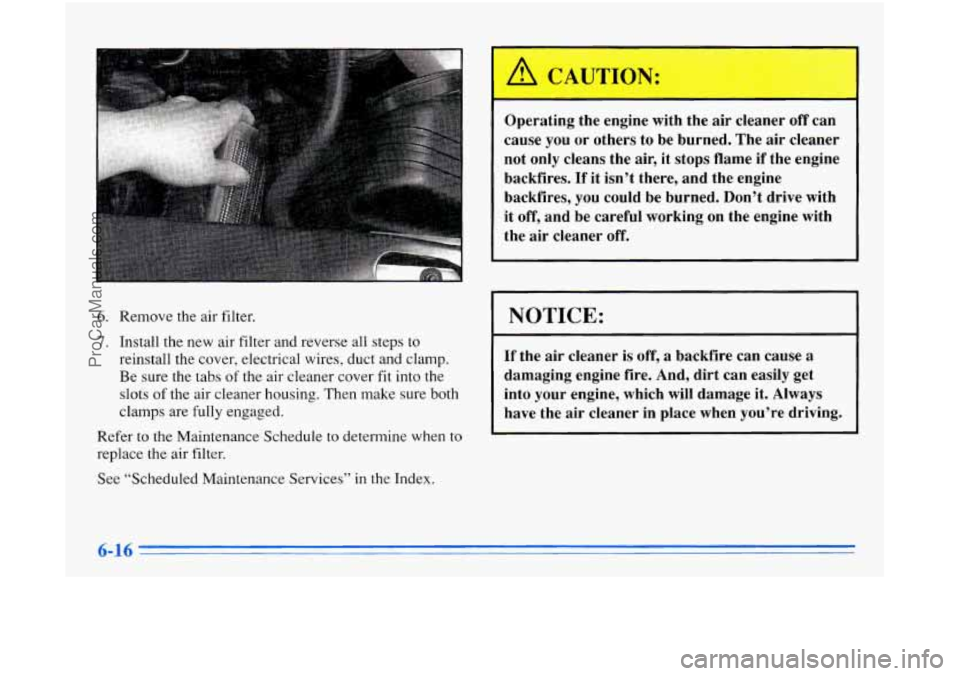
6. Remove the air filter.
7. Install the new air filter and reverse all steps to
reinstall the cover, electrical wires, duct and clamp.
Be sure the tabs
of the air cleaner cover fit into the
slots of the air cleaner housing. Then make sure both
clamps are fully engaged.
Refer
to the Maintenance Schedule to determine when to
replace
the air filter.
See “Scheduled Maintenance Services”
in the Index.
I
Operating the engine with the air cleaner off can
cause you or others to be burned. The air cleaner
not only cleans the air, it stops flame if the engine
backfires.
If it isn’t there, and the engine
backfires,
you could be burned. Don’t drive with
it
off, and be careful working on the engine with
the air cleaner
off.
NOTICE:
If the air cleaner is off, a backfire can cause a
damaging engine fire. And, dirt can easily get
into your engine, which will damage it. Always
have the air cleaner in place when
you’re driving.
ProCarManuals.com
Page 263 of 388
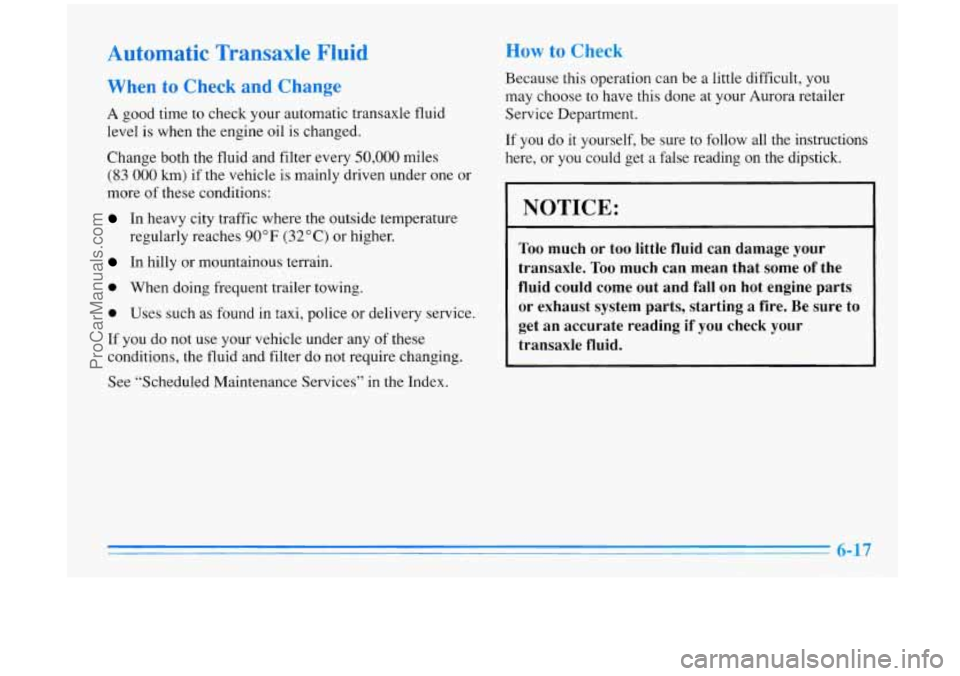
Automatic Transaxle Fluid
When to Check and Change
A good time to check your automatic transaxle fluid
level
is when the engine oil is changed.
Change both the fluid and filter every
50,000 miles
(83 000 km) if the vehicle is mainly driven under one or
more
of these conditions:
In heavy city traffic where the outside temperature
regularly reaches
90 OF (32 O C) or higher.
In hilly or mountainous terrain.
0 When doing frequent trailer towing.
0 Uses such as found in taxi, police or delivery service.
If you do not use your vehicle under any of these
conditions, the fluid and filter do not require changing.
See “Scheduled Maintenance Services” in the Index.
How to Check
Because this operation can be a little difficult, you
may choose to have this done at your Aurora retailer
Service Department.
If
you do it yourself, be sure to follow all the instructions
here, or
you could get a false reading on the dipstick.
I NOTICE:
Too much or too little fluid can damage your
transaxle.
Too much can mean that some of the
fluid could come out and fall on hot engine parts or exhaust system parts, starting a fire. Be sure to
get an accurate reading
if you check your
transaxle fluid.
ProCarManuals.com
Page 264 of 388

Wait at least 30 minutes before checking the transaxle
fluid level if
you have been driving:
0 When outside temperatures are above 90°F (32 " C).
At high speed for quite a while.
In heavy traffic -- especially in hot weather.
While pulling a trailer.
To get the right reading, the fluid should be at normal
operating temperature, which is 180°F to
200" F
(82°C to 93°C).
Get the vehicle warmed up by driving about
15 miles
(24
km) when outside temperatures are above 50°F
(10°C). If it's colder than 50°F (lO"C), you may have
to drive longer.
Park your vehicle on a level place. Keep the engine
running.
With the parking brake applied, place the shift lever
in PARK
(P).
With your foot on the brake pedal, move the shift
lever through each gear range, pausing for about
three seconds in each range. Then, position the shift
lever in PARK
(P).
Let the engine run at idle for three to five minutes.
Then, without shutting off the engine, follow
these steps:
1. Pull out the
dipstick and wipe
it with a clean rag
or paper towel.
2. Push it back in all the way, wait three seconds and
then pull it back out again.
ProCarManuals.com
Page 265 of 388
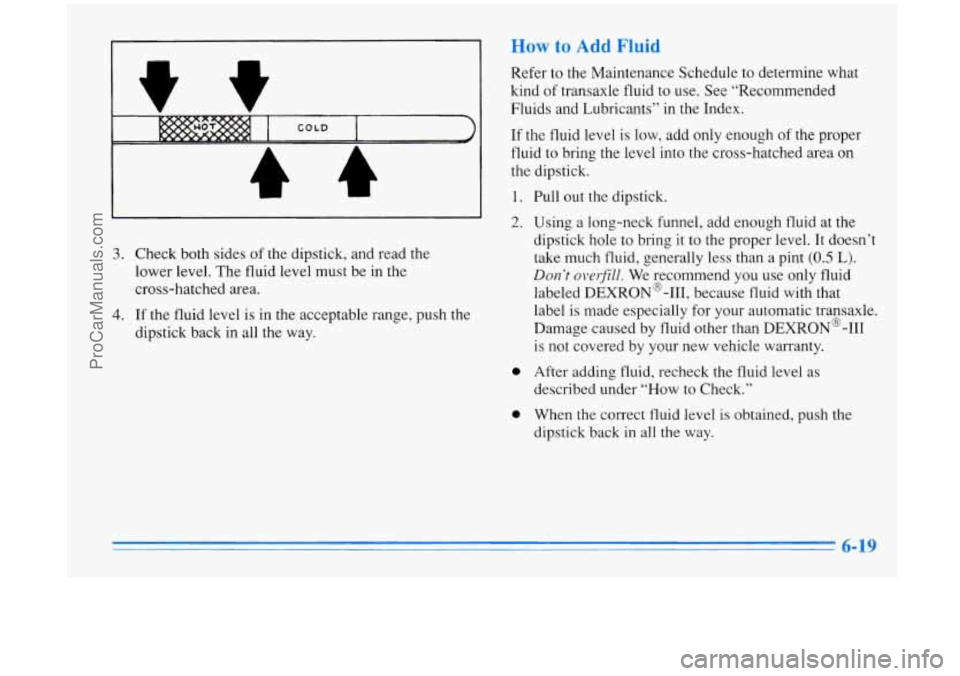
44
How to Add Fluid
Refer to the Maintenance Schedule to determine what
kind of transaxle fluid to use. See “Recommended
Fluids and Lubricants” in the Index.
If the fluid level is low, add only enough of the proper
fluid to bring the level into the cross-hatched area on
the dipstick.
1.
L.
3. Check both sides of the dipstick, and read the
lower level. The fluid level must be in the
cross-hatched area.
4. If the fluid level is in the acceptable range, push the
dipstick back in all the way.
0
0
Pull out the dipstick.
Using a long-neck funnel, add enough fluid at the
dipstick hole to bring it to the proper level. It doesn’t
take much fluid, generally less than a pint
(0.5 L).
Don’t overfill. We recommend you use only fluid
labeled DEXRON@-111, because fluid with that
label is made especially for your automatic transaxle.
Damage caused by fluid other than DEXRON@-I11
is not covered by your new vehicle warranty.
After adding fluid, recheck the fluid level as
described under
“How to Check.”
When
the correct fluid level is obtained, push the
dipstick back in all the way.
ProCarManuals.com
Page 266 of 388
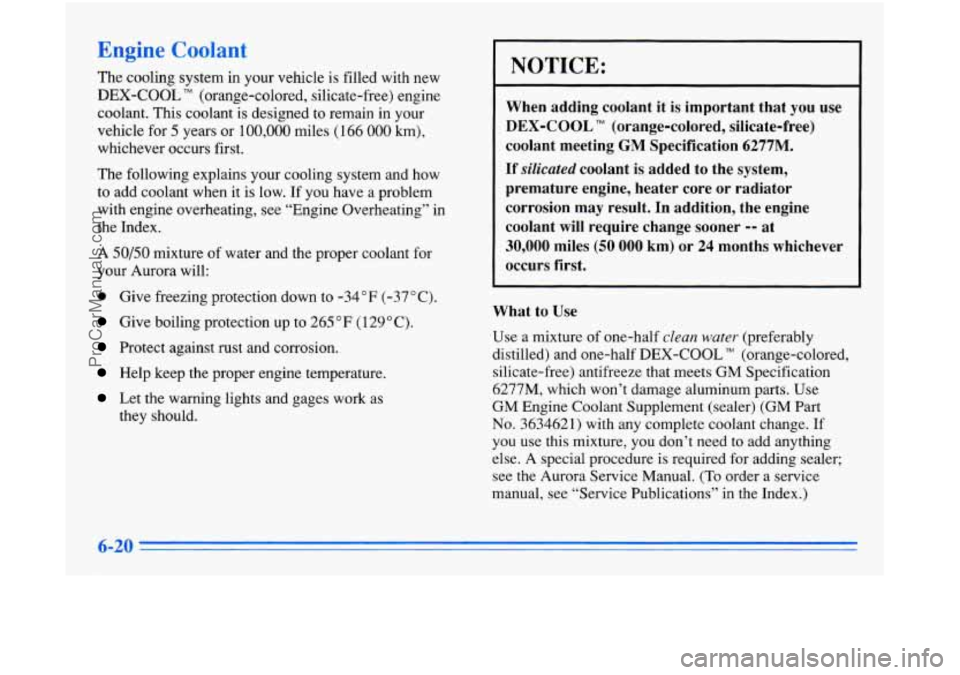
Engine Coolant
The cooling system in your vehicle is filled with new
DEX-COOL TM (orange-colored, silicate-free) engine
coolant. This coolant is designed to remain in your
vehicle for
5 years or 100,000 miles (1 66 000 km),
whichever occurs first.
The following explains your cooling system and how
to add coolant when
it is low. If you have a problem
with engine overheating, see “Engine Overheating” in
the Index.
A
50/50 mixture of water and the proper coolant for
your Aurora will:
0 Give freezing protection down to -34°F (-37°C).
Give boiling protection up to 265 “F (129°C).
Protect against rust and corrosion.
Help keep the proper engine temperature.
Let the warning lights and gages work as
they should.
NOTICE:
When adding coolant it is important that you use
DEX-COOL TM (orange-colored, silicate-free)
coolant meeting
GM Specification 6277M.
If
silicated coolant is added to the system,
premature engine, heater core or radiator
corrosion may result. In addition, the engine
coolant will require change sooner
-- at
30,000 miles (50 000 km) or 24 months whichever
occurs first.
What to Use
Use a mixture of one-half cEean, water (preferably
distilled) and one-half
DEX-COOL TM (orange-colored,
silicate-free) antifreeze that meets GM Specification
6277M, which won’t damage aluminum parts. Use
GM Engine Coolant Supplement (sealer) (GM Part
No. 3634621) with any complete coolant change. If
you use this mixture, you don’t need to add anything
else. A special procedure is required for adding sealer;
see the Aurora Service Manual.
(To order a service
manual, see “Service Publications’’ in the Index.)
ProCarManuals.com
Page 267 of 388

Adding only plain water to your cooling system
can be dangerous. Plain water, or some other
liquid like alcohol, can boil before the proper
coolant mix will. Your vehicle’s coolant warning
system
is set for the proper coolant mix. With
plain water or the wrong mix, your engine could
get too hot but you wouldn’t get the overheat
warning. Your engine could catch fire and you or
others could be burned. Use
a 50/50 mix of clean
water and
DEX-COOL TM (orange-colored,
silicate-free) antifreeze.
NOTICE:
If you us& an improper coolant mix, your engine
could overheat and be badly damaged. The
repair cost wouldn’t be covered by your
warranty. Too much water in the mix can freeze
and crack the engine, radiator, heater core and
other parts.
If you have to add coolant more than four times a year,
have your retailer check your cooling system.
I NOTICE:
If you use the proper coolant, you don’t have to
add extra inhibitors or additives which claim to
improve the system. These can be harmful.
ProCarManuals.com
Page 268 of 388

Checking Coolant
The engine coolant surge tank is located on the driver's
side
of the engine compartment.
-
A CAUTION:
Turning the surge tank pressure cap when the
engine and radiator are hot can allow steam and
scalding liquids to blow out and burn you badly.
Never turn the surge tank pressure cap
-- even a
little
-- when the engine and radiator are hot.
6-22
When your engine is cold, the coolant level should be at
the FULL COLD mark or a little higher.
If the message LOW ENGINE COOLANT is
displayed on your message center, it means
you
on engine coolant. 're
low
ProCarManuals.com
Page 269 of 388

You can be burned if you spill coolant on hot
engine parts. Coolant contains ethylene glycol,
and it will burn if the engine parts are hot
enough. Don’t spill coolant on a hot engine.
Adding Coolant
If you need more coolant, add the proper mix at the
surge tank, but only when the engine is cool. When
replacing the pressure cap, make sure it
is tight.
Thermostat
Engine coolant temperature is controlled by a thermostat
in the engine coolant system. The thermostat stops the
flow of coolant through the radiator until the coolant
reaches a preset temperature.
When you replace your thermostat, an
AC@ thermostat
is recommended.
ProCarManuals.com
Page 270 of 388
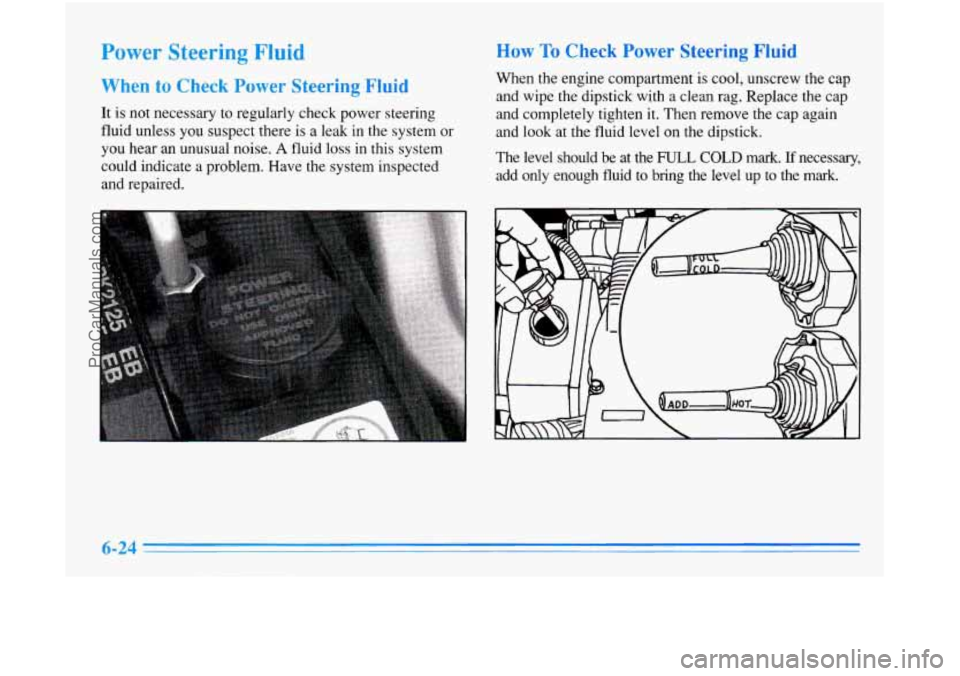
Power Steering Fluid
When to Check Power Steering Fluid
It is not necessary to regularly check power steering
fluid unless you suspect there is a leak in the system or
you hear an unusual noise.
A fluid loss in this system
could indicate a problem. Have the system inspected
and repaired.
How To Check Power Steering Fluid
When the engine compartment is cool, unscrew the cap
and wipe
the dipstick with a clean rag. Replace the cap
and completely tighten it. Then remove the cap again
and look at the fluid level on the dipstick.
The level should be at the
FU,L COLD mark. If necessary,
add only enough fluid to
bring the. level up to the mark.
ProCarManuals.com